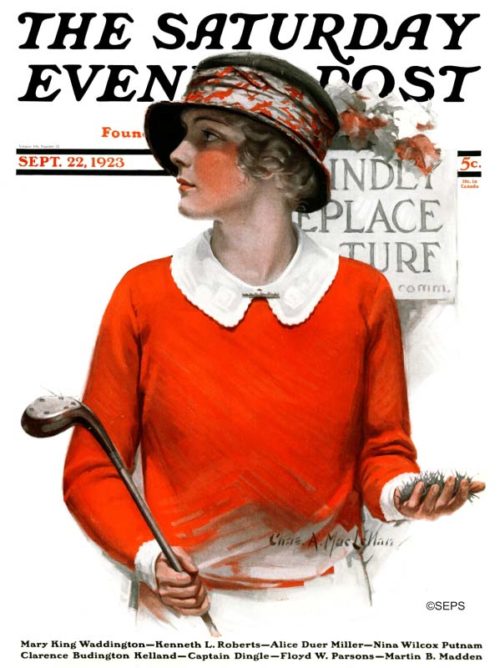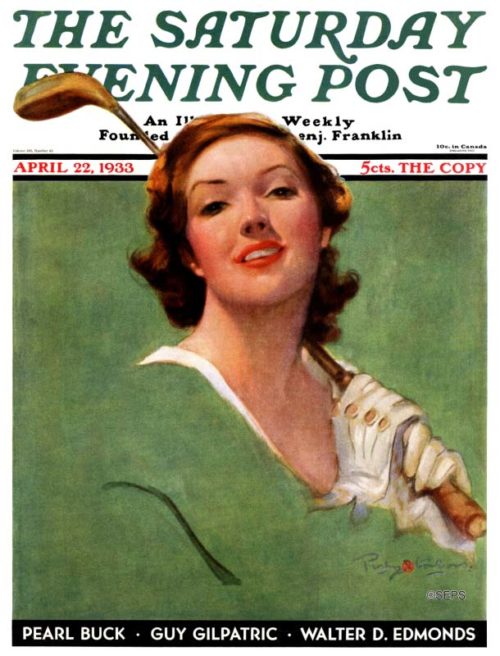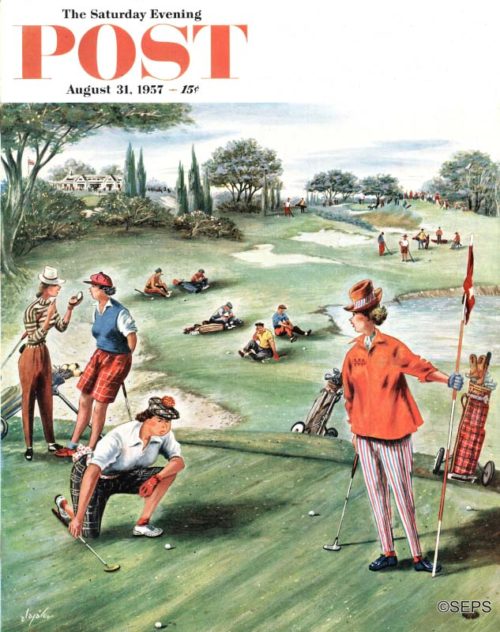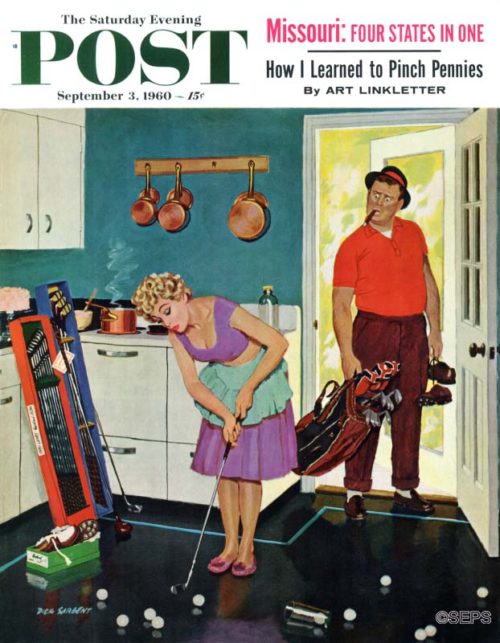Cover Gallery: Tee Time

Coles Phillips
November 11, 1922
Coles Phillips began drawing when he was just six years old. Phillips caught his big break as an artist after drawing only the ankles and feet of a person’s body while working at an “assembly-line” advertising firm. His depictions were so detailed that national companies wanted to identify him. Phillips is now recognized as the singular artist of his generation who invented the “fade away” style. His models, like this first-time lady golfer, brought such an elegant grace to the twentieth century’s rising tide of wealth and parties.

Charles A. MacLellan
September 22, 1923
Charles A. MacLellan started creating art for the Post during a time when narrative illustrations dominated the covers. His most memorable covers were those with children, typically boys. Often these boys were in some kind of trouble, but it’s the kind of trouble that makes their viewer smile. In his portraits of women, MacLellan nearly always drew them in action and often gave his models a prop, such as this woman holding a golf club—as well as a divot showing she couldn’t quite do it right.

John E. Sheridan
September 12, 1931
John E. Sheridan’s 14 covers for the Saturday Evening Post ran from 1918 to 1939. The covers are mostly sports related. The artist chose to focus on the greatness of American institutions such as baseball and the military, or in this cover’s case, golf. The artist’s style became less and less popular on the cover as other Post artists gained national recognition. Toward the end of his career, Sheridan accepted a teaching position in New York City at the Cartoonist’s and Illustrator’s School, also known as the School of Visual Arts. Today, his work is remembered as era-defining American sports and military.

Penrhyn Stanlaws
April 22, 1933
Penrhyn Stanlaws’ first cover with the Saturday Evening Post was in July 1913. He typically painted women dressed in their finery, and as color started making its way into many illustrations, Stanlaws usually added a singular element to punctuate the piece. The element, like this woman’s golf club, let the viewer explain the action on their own terms. His brush often added a soft illusion that gave a dreamy appeal to the characters he portrayed.

John Falter
July 3, 1948
The men John Falter used as models for his golf painting will be surprised at what has happened to the course. The golfers were playing a course near Phoenix, Arizona. Falter added trees he thought would look more general. Falter thinks all the men he painted are giants of industry, and we would identify them but for the fact that Falter probably moved faces and figures around. The trouble with a picture like this is that it leaves everybody wondering if the sand-trapped gent got out. If an artist can take liberties with the scenery, then we can give you the ending. He laid that shot right into the cup, making the rest of them look like amateurs.

Constantin Alajalov
August 31, 1957
Men play golf too intensely; it is unhealthy to get all lathered up about how many swats it takes to get a ball in a hole. Linksmen should sit down occasionally and soothe their nerves by contemplating the loveliness of nature—the placid ponds, the golden sands, the enchanting wilderness beyond the fairways. Oh, let’s change the subject. Alajalov wants to say that while those ladies are slow-pokes all right, some men golfers are even slower pokes—in fact, some women poke the ball faster than most men. He also wants to say that he didn’t design those clothes; he sketched from life and saw the pantaloons two fairways away. Alajalov plays golf, but when asked about his score, he said to tell you that his voice faded away because of telephone-circuit trouble.

Constantin Alajalov
July 2, 1960
“Golfe” was outlawed during its infancy in Scotland because too many archers, on whom the defense of the land rested, were golfing when they should have been on the archery range. Today it’s possible to play golf and shoot arrows (or daggers, at least) simultaneously; witness the baleful glare of the sourpuss on our cover. Artist Constantin Alajalov, who shoots in the high 80’s, sympathizes with sourpussses whose games are sabotaged by Sunbonnet Sam and his ilk. Sam is the so-and-so in the foreground who is loudly striking up an acquaintance while our jittery’ golfer asks himself, Isn’t that the chowderhead whose noisy, blankety-blank camera shutter cost me a stroke on the last green? Which helps explain why certain golfers appear to have a stroke every time they drop a stroke.

Richard Sargent
September 3, 1960
Question: “Is this the right way to hold the stick, dear?” Answer: “Oh, my achin’ back!” Male golfers have had to put up with this sort of thing ever since Mary, Queen of Scots, became addicted to the game more than four centuries ago. It’s unlikely, of course, that our cover lady will sink many long putts with the iron she’s holding. But there’s nothing wrong with her approach. (See cake at left, designed to repair her husband’s crestfallen expression and aching back.) Artist Dick Sargent informs us that we are in debt to his wife, Helen, whose example inspired this week’s cover. Mrs. Sargent splurged on a set of golf sticks a year ago and at last count had played a total of fifty holes. The total number of swings the lady took to play those holes is not a matter of public record.

Ben Kimberly Prins
July 8, 1961
How do you like that? On Saturday afternoon-prime time at any golf club-comes the deluge. Well, that’s par for the course, we suppose, and the course in this Ben Prins cover belongs to The Dunes Club of Myrtle Beach, South Carolina. That wave in the background is a fringe of the Atlantic Ocean. not the crest of an oncoming flood. The three-wheeled vehicle under the umbrella is what is known as a caddy car, and its occupants are either fair-weather athletes scurrying toward the indoor recreation of the nineteenth hole, or spirited souls bent on challenging their fellow duffers to a game of motorized water polo. At any rate they’re not slowing down at the putting green. The weather being what it is, they’re probably less concerned about sinking putts than about sinking, period.